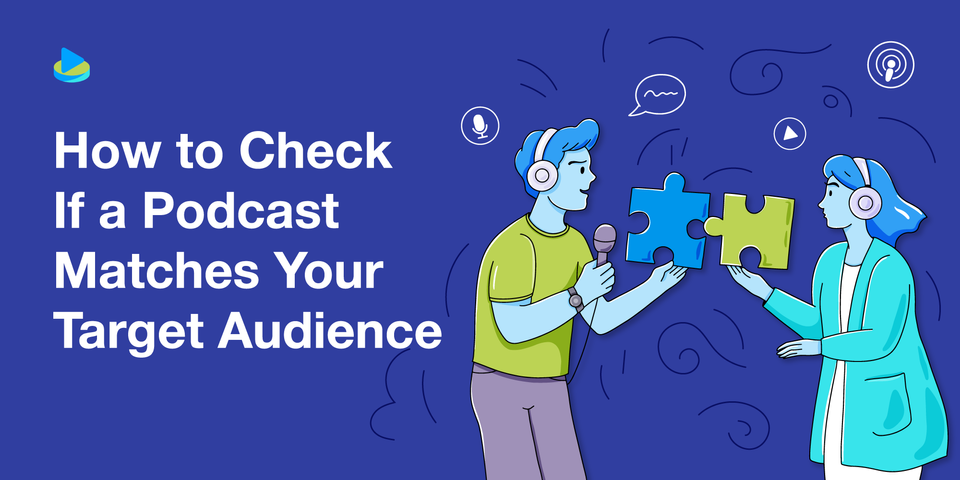The best podcast campaigns — whether guest interviews or ad spots — all have one thing in common: the right audience. In this guide, you’ll learn how to tell if a podcast’s listeners match your ideal customers, and how Rephonic’s audience insights can show you in seconds.
Key Takeaways
- Audience overlap determines campaign success, so focus on podcasts where your ideal customers already listen
- Manual podcast research wastes time and misses data
- Rephonic reveals audience data in seconds
Table of Contents
Why audience overlap makes a difference
Take this example from Rephonic's founder, James Potter.
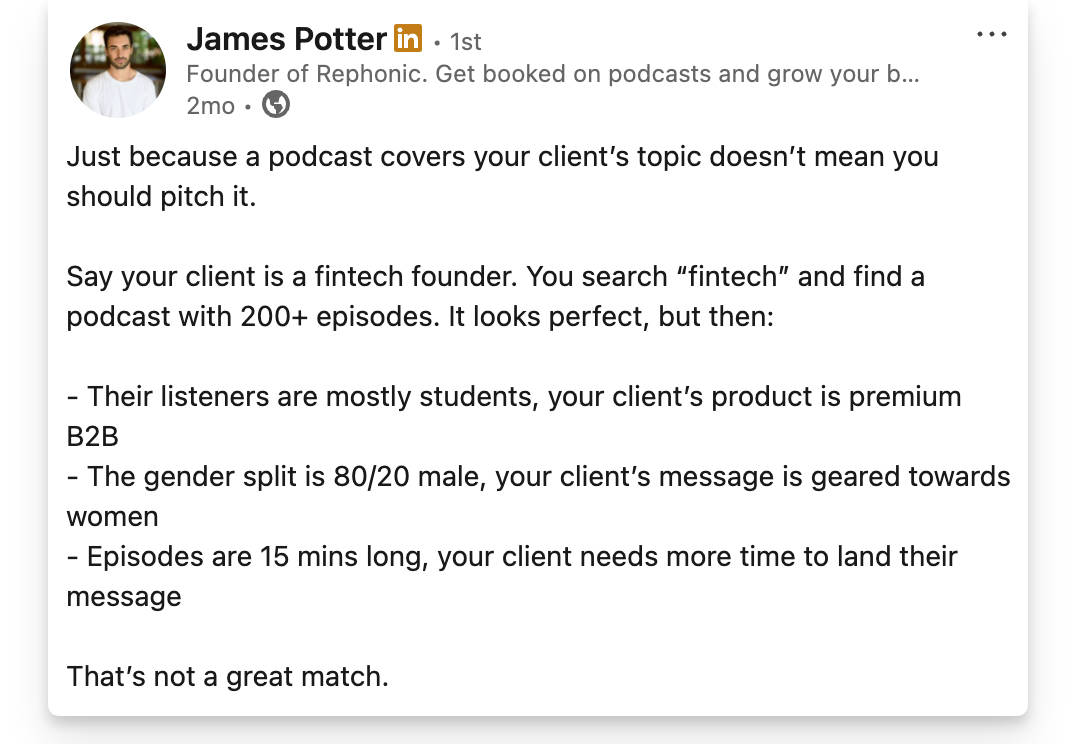
If the goal is to reach your target customers, then it's crucial to understand podcast audiences, but that might take longer than you imagine.
The factors that really matter when determining audience fit
- Industry or niche focus
- Audience demographics
- General feel
It’s not just about finding a podcast's download numbers or seeing how popular they are on social media. You'll need to research the podcast's audience, focus and general feel to understand whether partnering with a specific podcast will truly support your goals.
Industry or niche focus
Do your content, message, experiences and stories fit in with the podcast's themes?
Ideally, you'll be in the same niche and speaking to dedicated fans who understand where you're coming from and want to hear your message. Or the show's in an adjacent niche where your expertise adds to what they already care about.
For example, if you ran a SaaS platform for remote team management, a podcast dedicated to HR technology could be ideal.
But you might also align with shows in an adjacent niche like leadership or productivity. Your message about "Tools to manage people and projects effectively" might well interest their listeners (and could be a topic the hosts hadn't thought about covering before.)
Audience demographics
Do the podcast's listeners fit with your target audience?
Demographic data includes things like listeners' age range, their professions and interests, the countries where they tune in from, their education and income levels etc. The closer the match with your ideal customer the more likely listeners are to respond to your interview and follow up on your call to action.
In our (above) example from James Potter, his FinTech founder’s ideal customer is female and a decision-maker inside an established company ready to invest in premium B2B solutions. So, they’d be looking for podcasts with audiences that skew female, in a mid- to -older age range and likely well educated, with a substantial household income.
Overall feel
Does the podcast's vibe reflect your style?
This vibe includes factors like tone (is it casual and chatty or serious and formal?) and pace (fast-moving soundbites vs. in-depth discussions.)
Consider the host's interview style, too. Are the episodes free-flowing discussions or structured Q&As? Do they focus on beginner-friendly topics or cater to advanced professionals? What are the audience expectations: entertainment, knowledge or a mixture of both?
Each of these vibes is great for the right audience. The question is, do they match your company's style and image or not?
Five ways to check audience overlap
- Audience surveys
- Listen to episodes
- Review guest history
- Scan social media
- Use Rephonic
1. Audience surveys
Hosts sometimes survey their audiences to see who’s listening and whether their content is still on track with their goals. They may publish listener demographics or case studies to attract advertisers and to show potential listeners that people like them enjoy the show.
Example: In 2022, Feeling Good sent out a survey for insights into its listeners’ interests and demographics. The team published the resulting information on its website.
2. Listen to episodes
Listen to several episodes to get an insight into the general format, how the host conducts interviews and the show's overall vibe.
You’ll quickly get a feel for whether the host keeps things light and fast or digs into meaty discussions. Notice how they treat their guests. For example, do they:
- Guide the conversation smoothly, or cut things short?
- Inject their own experiences or keep it firmly focused on the guest?
- Ask 'signature questions' during the interview? (It’s common for hosts to have trademark questions or routines they use in every interview.)
- Invite CTAs from their guests?
Understanding the format can make all the difference in how your message lands.
3. Review guest history
Open the podcast in your app and scan through the episode titles and descriptions to see who’s already been featured.
Look at whether they tend to invite industry experts, founders, authors, or influencers, and note how closely those guests resemble your target audience or peers.
If you spot competitors or people with a similar offer to yours, it’s a strong sign the show could be a good fit. But if the guest list feels too general or unrelated, the audience probably won't be ready to act on your message.
4. Scan social media
Find the podcast's social media platforms, and check the host's personal socials too. Their choice of platform, what they post and how they respond to comments often provide insights into listener engagement and how the hosts relate to their audience.
At the very least, you should see links to episodes, soundbites of published episodes and teasers for up-coming interviews.
You might also see announcements, awards, sponsorship mentions and tags. Educational or industry-focused podcasts sometimes publish posts that expand on discussions or questions in specific interviews, too.
You might check follower numbers and likes, but comments will give you more insight into the audience's thoughts and how people are responding to the show. Note how the hosts answer their fans—do they keep their responses short? Or do they encourage more dialogue by asking questions or adding more of their own thoughts in the comments section?
5. Use Rephonic
Rephonic puts everything you need to assess podcast-audience fit into one platform. Instead of hopping between apps and spreadsheets, you can:
- See detailed listener demographics for over three million podcasts.
- Compare a podcast’s listener profile with your ideal customer.
- Research past guests and sponsors.
- Browse social stats and links in one place.
In minutes, you can decide if a podcast is the right match for your campaign, so you spend time and budget on opportunities that reach the people you want.
How Rephonic helps you understand a podcast's audience
Suppose you've found a podcast in your industry that you'd like to sponsor or be a guest on. Next step: use Rephonic to research its audience, episodes, past guests/sponsors and social media platforms.
We'll follow Taylor Swift's lead and use the New Heights with Jason & Travis Kelce podcast for our demo. So, here's how you do it:
Review the podcast's detailed Audience page
Here's our New Heights audience demographic data page.
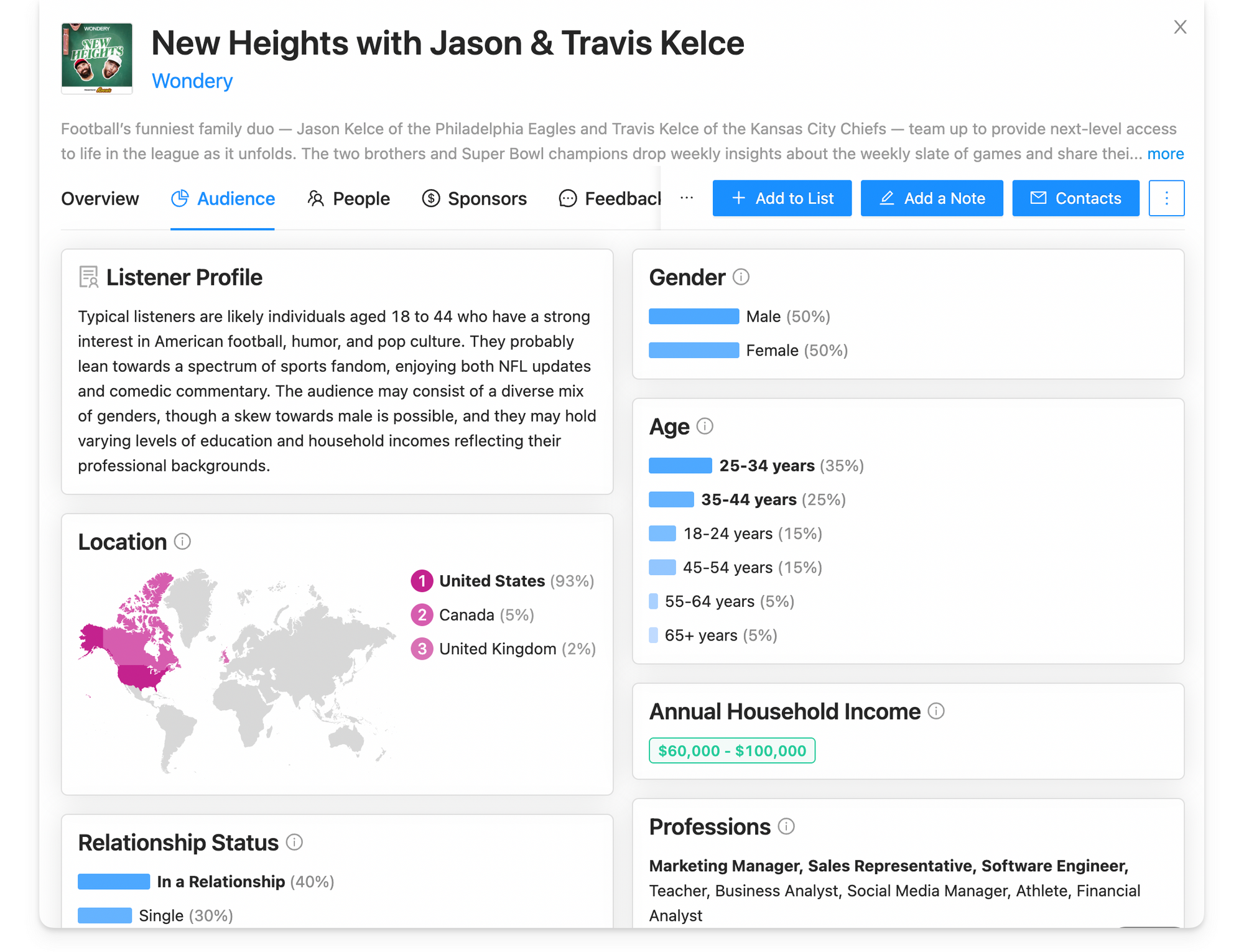
The audience demographics analysis goes well beyond a simple gender or age mix.
Start with the typical listener profile, and our best estimate of the countries where most listeners are located, their age-range and gender mix.
Then dig deeper into their likely relationship and parental status, education levels, professions, interests and even an annual income range.
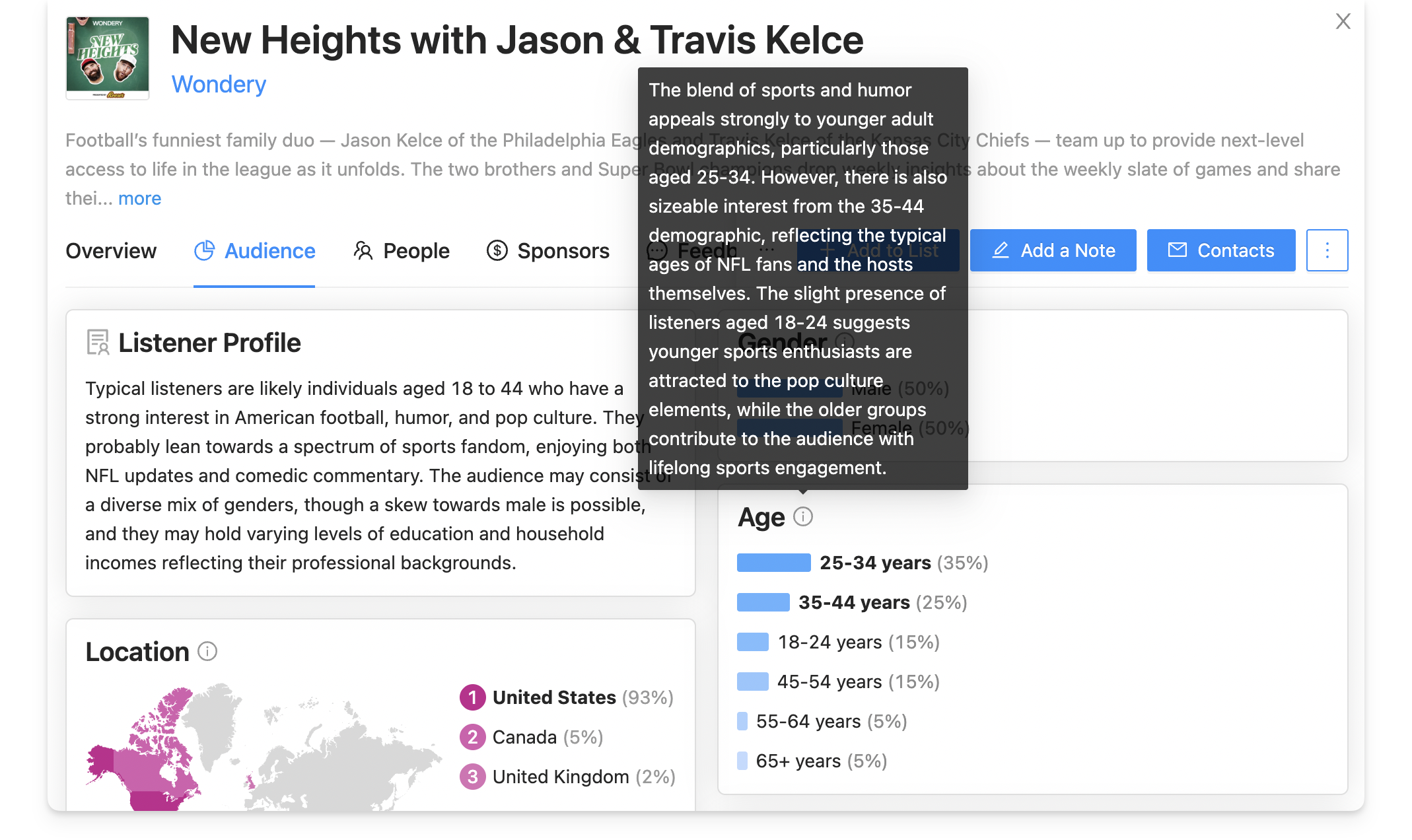
Now, with your target market in mind, check the podcast listeners profile against that of your own audience. How much overlap can you see?
Get convenient episode links and transcripts
Yes, you can find and listen to episodes on any podcast app or player. But, from my pre-Rephonic days, I can attest that searching for a particular episode can take a while, especially if you're on a podcast's own website as they often only load a few episodes at a time. It's even worse if you want to find specific segments within an episode.
On Rephonic, I just click straight to the latest episode from the podcast's Overview page, or open the episode page via the "More Episodes" button to view or listen to previous episodes.
Sometimes, you'll want to see what guests said about a specific topic (perhaps the one you're planning to pitch your interview about.) So, type that topic or keyword into the search to bring up all this podcast's episodes on that topic. (Watch a demo.)
Previous episodes have a Transcript button, too. Click it to read the text or search for specific keywords, phrases or topics mentioned in that episode.
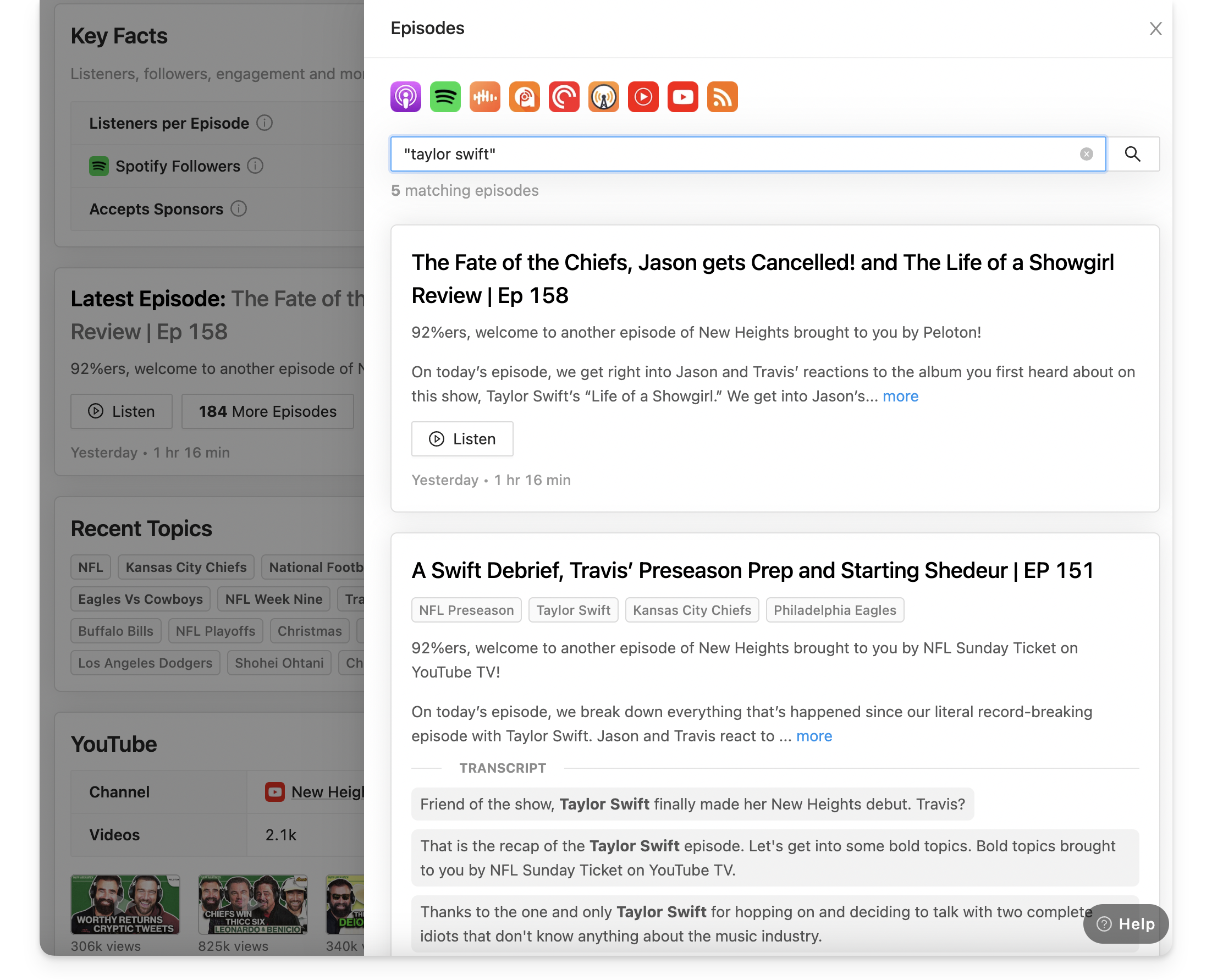
Research previous guests and sponsors
Another way to determine audience overlap is by seeing who else has guested on or sponsored the show and asking:
- Would your target audience also enjoy listening to or learning from those guests?
- Do they represent the industry, expertise level, or values that your audience expects?
- Are previous sponsors aligned with your brand values and message?
- Do the guests or sponsors complement what you offer (or are they direct competitors)?
By analyzing who else has featured, you can gauge whether this podcast audience is one you’re trying to reach.
It's a lot to think about—which is where Rephonic's People and Sponsors tabs come in.
These tabs list the podcast's previous guests or sponsors/advertisers, explain why they're relevant to that audience and include a direct link to their episode. If you need to see if a particular person or company has been on the show, each tab includes a search bar. Type the name and go straight to that episode or ad.
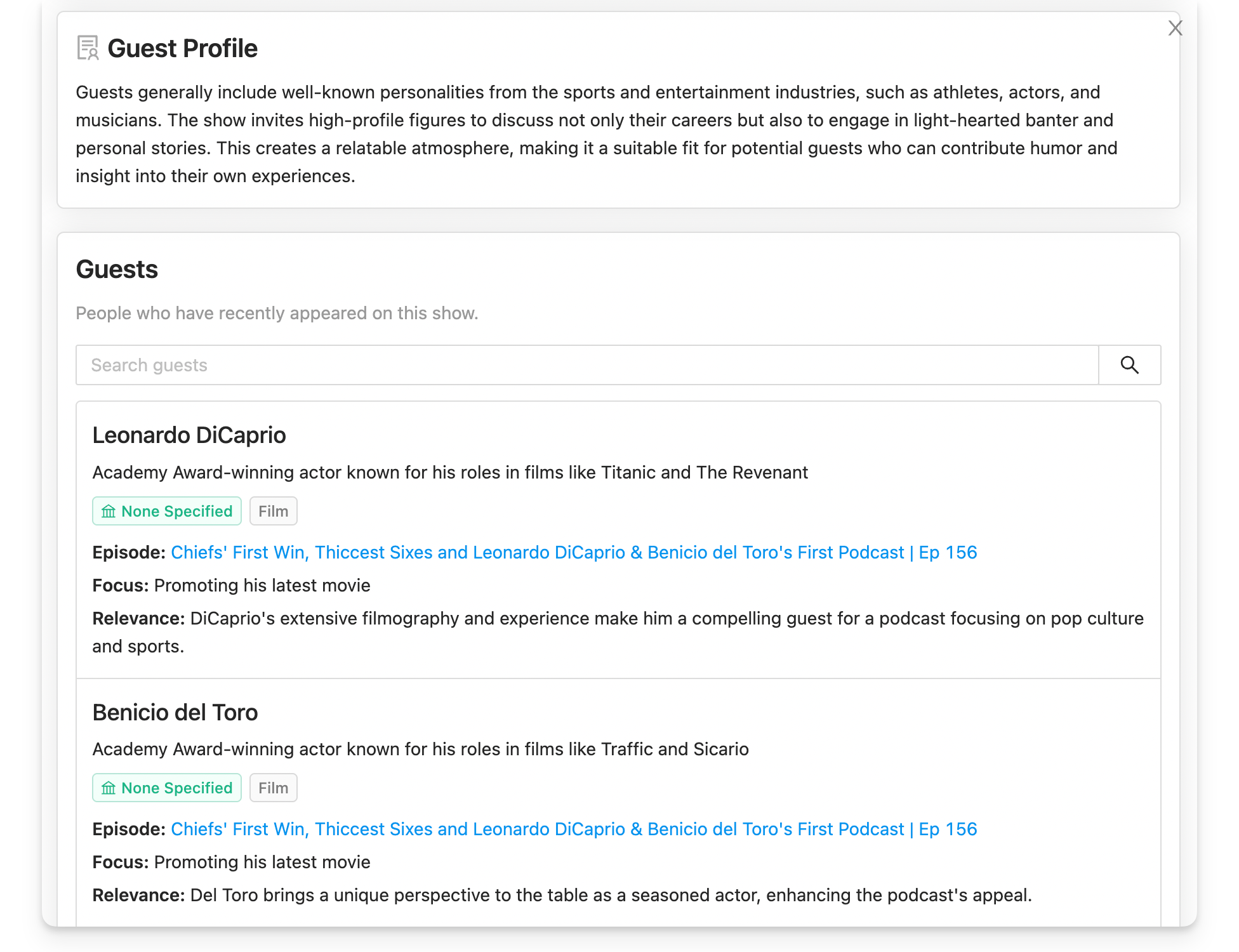
Social media links
Social channels also help you gauge audience overlap. Consider these points:
- What social channels is the podcast on?
- Are they the same channels your audience uses?
- What are the hosts posting on social media?
- How do their listeners or followers react?
Find out by checking their social media platforms. You'll find the links in Contacts (top right on every tab) and links & follower numbers in the Social section on the Overview tab.
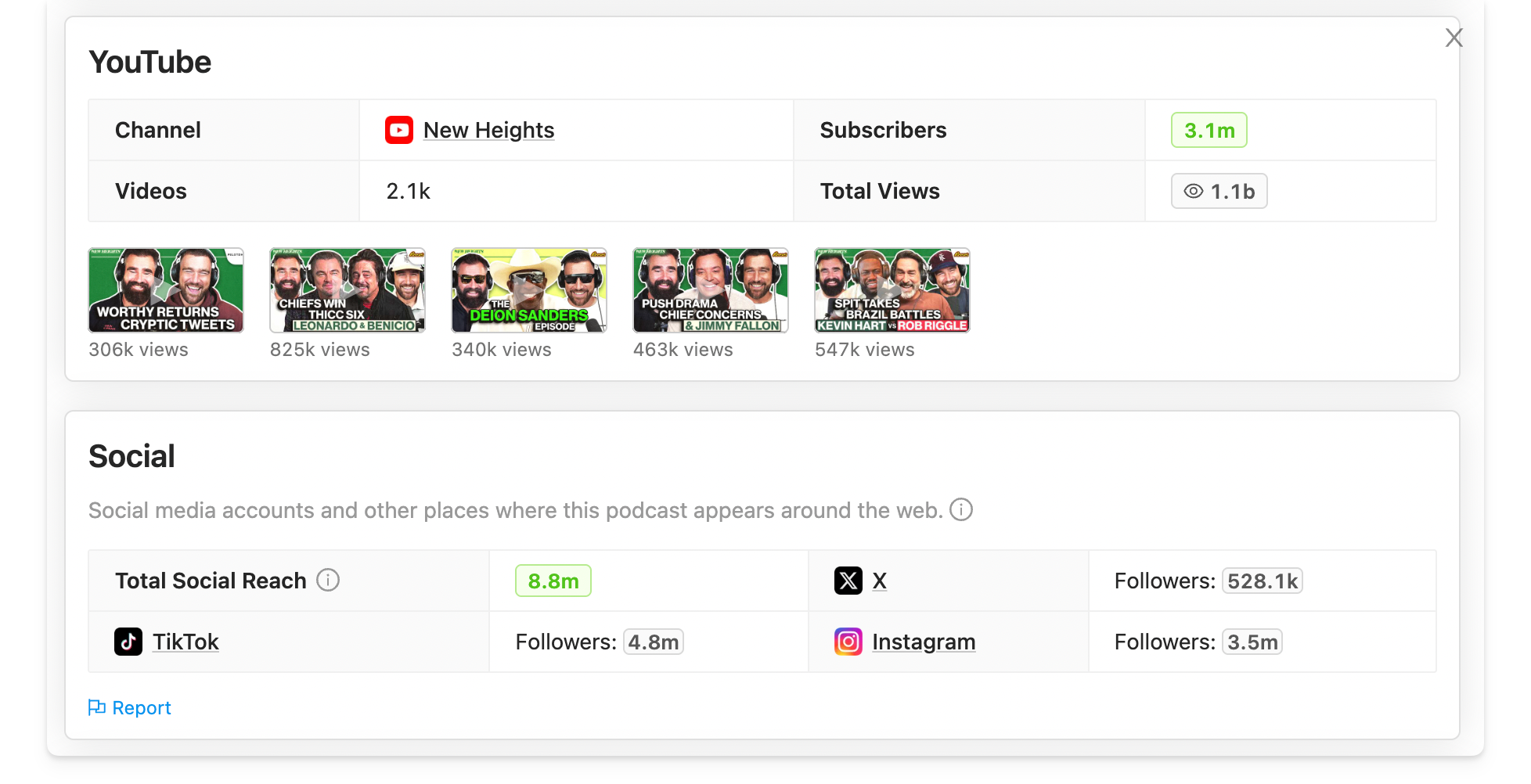
What are the benefits of using Rephonic?
Everything you need is all in one place—from audience insights to guest history and social links.
That saves you hours of digging.
Ultimately, you'll make smarter decisions about which podcasts will actually connect with your target audience and have more time to spend pitching, prepping and delivering great interviews to an audience that's primed and ready to listen and act.
Putting it all together (Step-by-step framework)
- Step 1: Define your ICP (ideal customer profile): Who are they? Where do they live? What education, relationships, interests, jobs etc. do they have? What do they need from you? Who do they admire and would love to hear interviewed? What social media platforms do they prefer?
- Step 2: Shortlist podcasts: Find them manually or with Rephonic's database (and keep it organized all in one place with our pipeline manager.)
- Step 3: Check guest history & host positioning: Do they gel with your brand, mission and ICP (suggesting strong audience overlap) or do they represent very different segments?
- Step 4: Validate audience data: Wherever it's available, or shortcut the search and use Rephonic.
- Step 5: Prioritize shows with the best overlap.
- Step 6: Pitch those podcasts. (Read A Beginner's Guide to Writing a Podcast Guest Pitch first.)
Final thoughts
Finding podcasts with real audience overlap isn’t always simple, but it’s the difference between wasted effort and real results. So, focus on shows where your ideal customers are already listening, to turn podcast guesting or advertising into a powerful growth channel.
Rephonic helps you make informed choices on the podcasts with the most audience overlap.
And while you might find much of that info scattered far and wide on the web, you'll save precious time and effort by having it all in one place.
Why guess when you can know? Put yourself where your customers are already listening. Start a 7-day free trial with Rephonic.
Article credits

Written by Lyn McNamee, podcast-PR writer with four years of experience transforming podcast insights into practical, results-focused playbooks.

Edited by Becca Butcher, marketing specialist who frequently analyzes Rephonic’s data across 3 million podcasts.
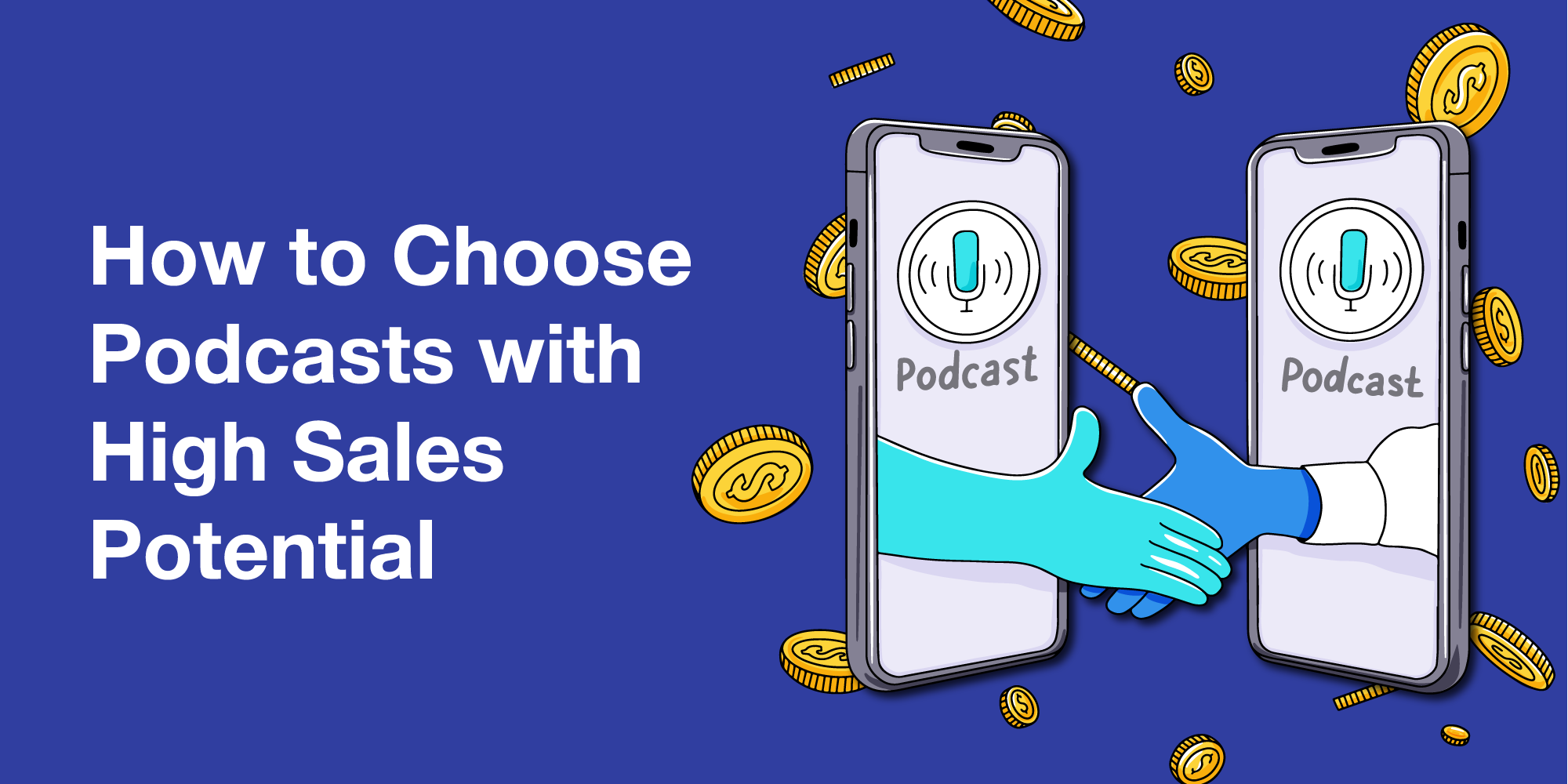
How to Choose Podcasts with High Sales Potential for Podcast Guesting
Podcast guesting builds brand awareness—but not every show will bring in customers. This article shows you how to find podcasts with real sales potential, so your time behind the mic pays off.
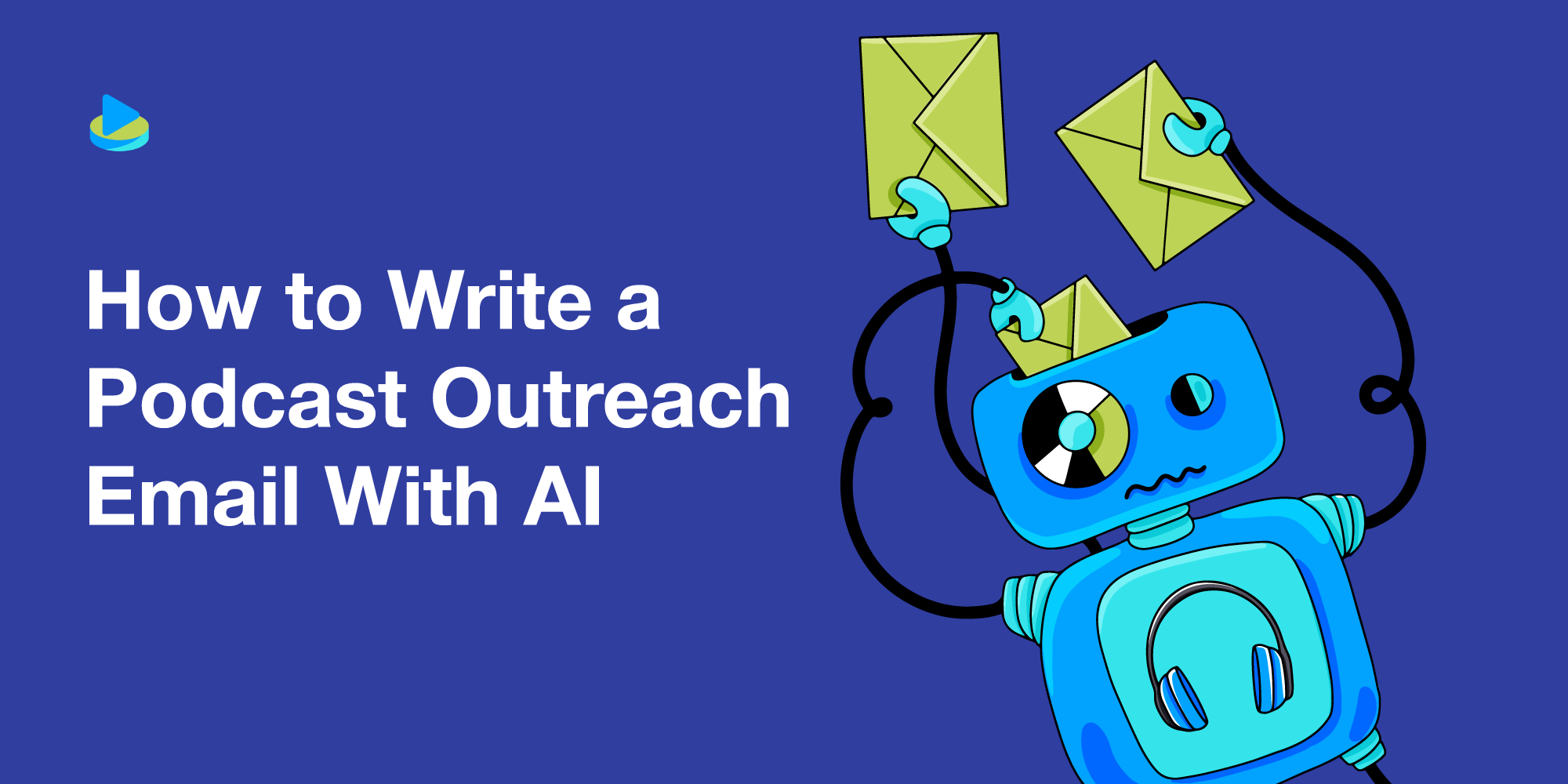
How to Write a Podcast Outreach Email With AI (And What to Avoid)
Can AI help you write an effective podcast outreach email? Yes, but it won't give you a winning email at your first attempt. Be smart and use AI for research first. Here's how you do it.

